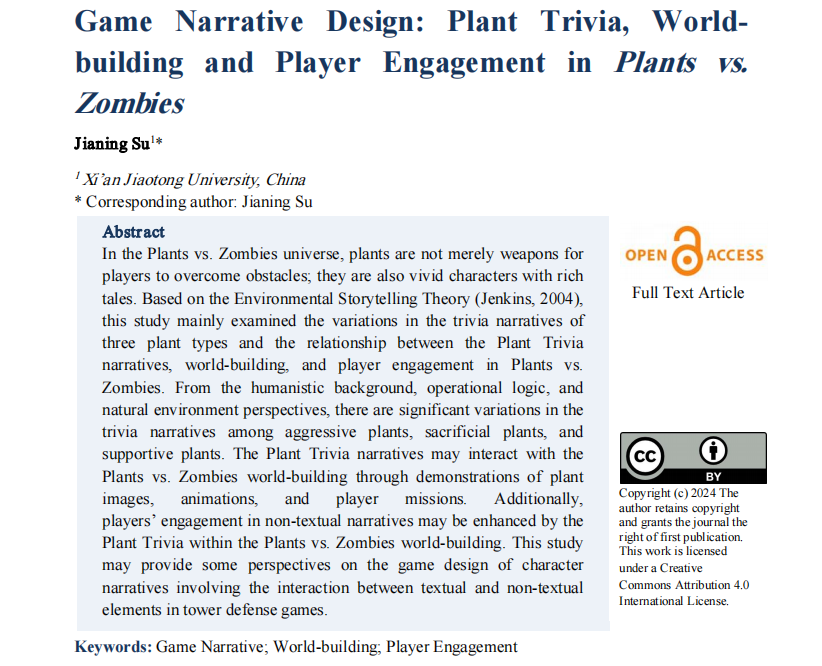Game Narrative Design: Plant Trivia, World-building and Player Engagement in Plants vs. Zombies
DOI:
https://doi.org/10.5281/zenodo.14554610Keywords:
Game Narrative, World-building, Player EngagementAbstract
In the Plants vs. Zombies universe, plants are not merely weapons for players to overcome obstacles; they are also vivid characters with rich tales. Based on the Environmental Storytelling Theory (Jenkins, 2004), this study mainly examined the variations in the trivia narratives of three plant types and the relationship between the Plant Trivia narratives, world-building, and player engagement in Plants vs. Zombies. From the humanistic background, operational logic, and natural environment perspectives, there are significant variations in the trivia narratives among aggressive plants, sacrificial plants, and supportive plants. The Plant Trivia narratives may interact with the Plants vs. Zombies world-building through demonstrations of plant images, animations, and player missions. Additionally, players’ engagement in non-textual narratives may be enhanced by the Plant Trivia within the Plants vs. Zombies world-building. This study may provide some perspectives on the game design of character narratives involving the interaction between textual and non-textual elements in tower defense games.
References
[1]Bellini, M. (2021). Formal organization and complex responses to video games narratives. Proceedings of the ACM on Human-Computer Interaction, 5(CHI PLAY), 1-17.
[2]Bopp, J. A., Müller, L. J., Aeschbach, L. F., Opwis, K., & Mekler, E. D. (2019, October). Exploring emotional attachment to game characters. In Proceedings of the Annual Symposium on Computer-Human Interaction in Play (pp. 313-324).
[3]Burgess, J., & Jones, C. (2022). Exploring emergent co-creative narrative in a strategy video game brand. Journal of Media Business Studies, 19(3), 185-202.
[4]Cardona-Rivera, R. E., Zagal, J. P., & Debus, M. S. (2023). Aligning story and gameplay through narrative goals. Entertainment Computing, 47, 100577.
[5]Heussner, T., Finley, T. K., Hepler, J. B., & Lemay, A. (2015). The game narrative toolbox. Routledge.
[6]Jenkins, H. (2004). Game Design as Narrative Architecture.
[7]Johannes, N., Vuorre, M., & Przybylski, A. K. (2021). Video game play is positively correlated with well-being. Royal Society open science, 8(2), 202049.
[8]Johnson, M. R. (2020). The place of culture, society, and politics in video game world-building. In World-Builders on World-Building (pp. 110-131). Routledge.
[9]Koenitz, H. (2024). Narrative in video games. In Encyclopedia of computer graphics and games (pp. 1230-1238). Cham: Springer International Publishing.
[10]Lammes, S., & de Smale, S. (2018). Hybridity, reflexivity and mapping: A collaborative ethnography of postcolonial gameplay. Open Library of Humanities, 4(1).
[11]Lu, A. S., Green, M. C., & Thompson, D. (2019). Using narrative game design to increase children’s physical activity: Exploratory thematic analysis. JMIR serious games, 7(4), e16031.
[12]Maine, F. (2017). The bothersome crow people and the silent princess: exploring the orientations of children as they play a digital narrative game. Literacy, 51(3), 138-146.
[13]Paterson, E., Williams, T., & Cordner, W. (2019). Once Upon a Pixel: Storytelling and Worldbuilding in Video Games. CRC Press.
[14]Sengun, S. (2022). Six degrees of videogame narrative. Games and Narrative: Theory and Practice, 3-20.
[15]Tang, J., & Zhang, P. (2019). Exploring the relationships between gamification and motivational needs in technology design. International Journal of Crowd Science, 3(1), 87-103.
[16]Yap, K., Yap, K. Z., Ghani, M. B. A., Yap, J., & Athreya, U. S. (2016). “PLANTS VS ZOMBIES”–STUDENTS’EXPERIENCES WITH AN IN-HOUSE PHARMACY SERIOUS GAME. In EDULEARN16 Proceedings (pp. 9049-9053). IATED.
[17]Zhang, Q. (2015, November). Research on Life-and-Death Education in the Plants Vs Zombies. In 2015 International Conference on Social Science, Education Management and Sports Education (pp. 303-305). Atlantis Press.

Downloads
Published
How to Cite
Issue
Section
License
Copyright (c) 2024 Jianing Su

This work is licensed under a Creative Commons Attribution 4.0 International License.


























